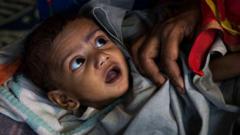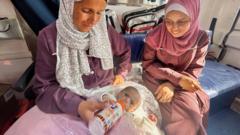Despite significant strides in addressing malnutrition, India still has a higher child stunting rate than Sub-Saharan Africa, driven in part by entrenched caste systems. New research stresses the importance of addressing social disparities alongside nutritional interventions to improve child growth outcomes.
Child Malnutrition in India: Caste and Nutrition Gap Under Scrutiny

Child Malnutrition in India: Caste and Nutrition Gap Under Scrutiny
A recent study highlights the role of caste discrimination in India's higher child stunting rates compared to Sub-Saharan Africa, raising new questions about the impact of social identity on malnutrition.
The ongoing child stunting crisis in India reveals a complex tapestry of historical, social, and dietary influences. Official statistics indicate that about 35% of India's 137 million children under five are stunted—a figure surpassing that of Sub-Saharan Africa, which averages 33.6%. This issue highlights a pressing global concern, as together, both regions make up 44% of the world’s under-five population but account for around 70% of the global stunted child demographic.
The nuances of this situation are explored in a study conducted by researchers Ashwini Deshpande from Ashoka University and Rajesh Ramachandran from Monash University, Malaysia. They argue that simply measuring height gaps between Indian and Sub-Saharan African children does not adequately tackle the root causes of malnutrition, particularly the detrimental effects of caste discrimination in India.
The first 1,000 days of a child's life are crucial for their long-term development, impacting access to nutrition, healthcare, and education. While both India and Sub-Saharan Africa experience similar socio-economic challenges—including widespread poverty—India’s rigid caste hierarchy presents unique barriers to nutritional equity.
The researchers utilized official government data to draw comparisons between India and 19 Sub-Saharan African countries. They found a staggering figure: over a third of Indian children under five are not only stunted but also underweight. Notably, children from higher-caste groups displayed significantly better health outcomes compared to their marginalized counterparts, such as adivasis and Dalits, who make up a considerable portion of the under-five demographic.
The analysis revealed that children from higher-ranking caste groups were roughly 20% less likely to face stunting than those from marginalized sections, even when controlling for factors like maternal education, sanitation, and socio-economic status. The researchers suggest that improved access to food and health resources facilitates better growth prospects among children from socially advantaged backgrounds.
Contrastingly, while some scholars speculate that genetic factors may contribute to the height differences, the overwhelming consensus in this study emphasizes socio-economic determinants rooted in caste and educational disparities.
Despite a reduction in stunting rates across various social strata in India over recent years, children from poorer families with less-educated mothers and marginalized communities remain at severe risk. Recent studies also indicate a decline in stunting across Sub-Saharan Africa, although the actual number of stunted children remains troubling.
The disparity in child growth metrics underscores the importance of integrating social identity considerations—particularly caste—into strategies aimed at combating malnutrition. The study harnessed data from national health surveys, accessing information on 195,024 children under five in India and 202,557 in Sub-Saharan Africa.
By examining the intricate interrelations between caste, economics, and health, this research paints a comprehensive picture of India's battle against child malnutrition—a challenge that cannot solely rely on nutritional supplementation but must also address deep-seated social inequalities.























